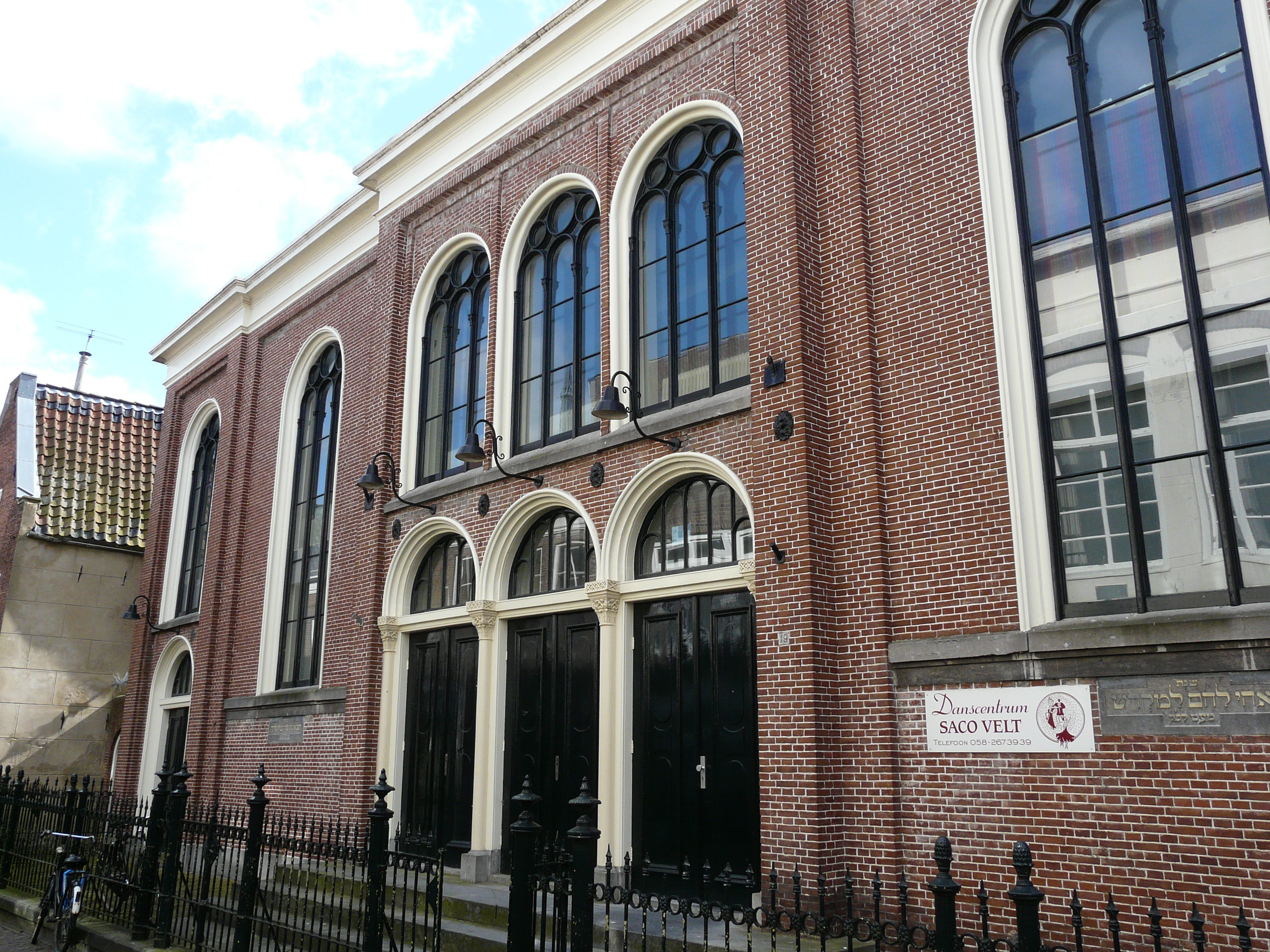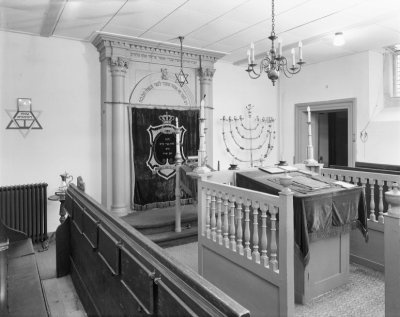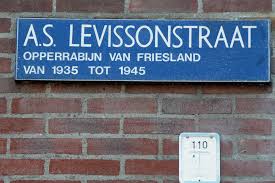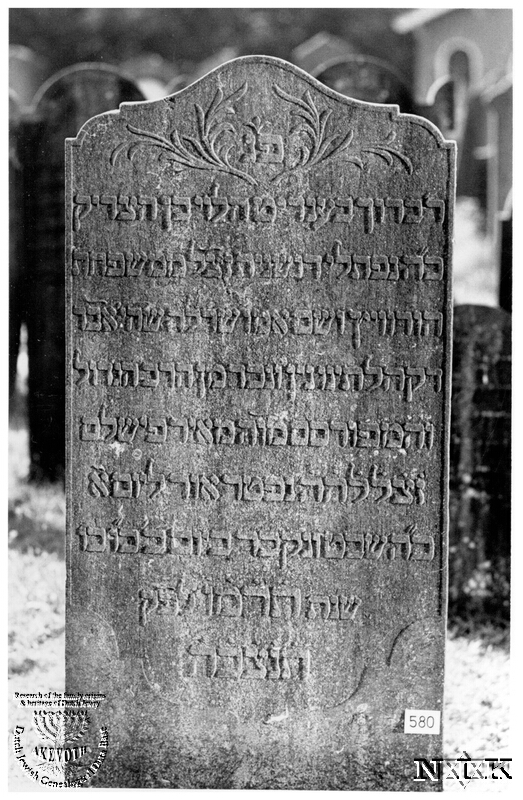The Jewish community of the city of Leeuwarden
Sources: ‘Pinkas hakehilloth’ by Jozeph Michman, Hartog Beem and Dan Michman
Gens Nostra
Internet
Introduction
A Frisian legend has it that it was after the destruction of the Second Temple that the Romans banished some Jews to the province of Friesland, located on the edge of the Roman Empire. Which would mean that these exiles should be considered as the forefathers of the Frisian people. There is however no historical foundation for this story.
In the Middle Ages there were no Jews in Leeuwarden, but in the 17th century many Jews left Germany to escape the horrors and persecutions of the Thirty Years’ war in search of more peaceful regions. Some of them, probably from Emden and Ostfriesland, found their way to Leeuwarden.
The first evidence of Jews in Leeuwarden comes from 1645, when the city council ordered all Jewish residents to register. Population counts of city residents were carried out now and again, when they had to provide information about their stay.
A document of 1677 which mentions a wedding, contains the names of a few Jews from Leeuwarden.
Services were held in Leeuwarden from 1700, initially in a building near the Amelandspijp on the Oude Ee river.
Cemetery
In 1679 the city council permitted the purchase of a piece of land for a cemetery along the city wall in the Boterhoek, referred to as the ‘Jodenkerkhof’ (Jews’ cemetery), near the Oldehoof tower on the bulwark. This cemetery was in use for many years, and was extended in 1739, 1760 and 1771. Permission was given to build a surrounding wall in 1712. When the cemetery ran out of space due to the expanding Jewish population, a new one was erected along the Groeneweg, and in 1833 a third was in use along the Spanjaardslaan. In the summer of 1998 the foundation Penance and Reconciliation cleaned it up.
Restrictions
In the course of the 18th century the presence of Jews was tolerated by the local authorities, and local traders were defended. However during the 18th and 19th centuries there were continual measures to limit the arrival of poor Jews and any resulting trouble. The city’s gatekeepers were given orders in 1712 to keep out unknown Jews, and in 1716 they were told to carry out this order with greater diligence. In those days provicial authorities forbade the arrival of Jews for fear of diseases being transmitted through their old, ragged clothes.
All Jewish residents were recorded in a special register. Those who had lived in the city for less than three years, were told to leave. Anyone who had entered the province after 1720, had to leave as well, and skippers and coachmen were told not to bring in Jews.
In 1745 Jews were forbidden to offer their wares in the street, to carry out various trades and to slaughter cattle on Sundays. In 1771 Jewish children were no longer allowed to be taught in Jewish schools on Sundays. The Parnassim (community leaders) were instructed to report every Jew who spent the night in the city.
In 1754 the city’s Jewish community drew up rules and regulations which were approved by the city council. All Jews were registered, and those who had stayed in the city for less than three years, were denied residence. In 1738 the city council complained to the provincial authorities that the Jews should take care of their own poor.
In 1786 the Parnassim complained about the dire financial situation of the Jewish community, after which members who refused to pay tax, were forced to do so. However, this complaint led to the enforcement of new measures to make it even more difficult for poor Jews to live in the city. Next it was decided that Jews who had lived in the city for less than five years, had to leave. Foreign Jews could only come to live in the city, if they could prove that they had reasonable means of supporting themselves. Yet despite these measures the number of Jews in the city increased.
From 1796, during the French Revolution, the position of Jews improved gradually. In 1809 the Saturday market was even moved to Friday to enable Jewish merchants to take part. In 1812 it became compulsory for Jews to adopt family names.
Means of existence
There were a few guilds which Jews could join from 1740, but they still did not have the right to vote. Guilds sometimes took anti-Jewish measures, especially against unknown Jews. Thus in 1771 a guild forced a foreign Jew to close his shop and confine his trading to the annual fair, because he had apparently not followed the guild’s rules and disadvantaged local citizens. Jews were mostly employed as butchers, shopkeepers, salesmen and pedlars, but in the 20th century there were a few craftsmen, doctors, professors and civil servants among them. There was also a fat factory, a shoe factory and a metal factory with a Jewish owner.
Before the Second World War there were 159 Jews who had to pay tax, 49 of whom had an income of less than 1000 guilders per year. One of them had an income of more than 10,000 guilders. The incomes of 112 Jews were below the tax threshold. These data show that the Jewish community of Leeuwarden’s was not a rich one, even though the number of people receiving support was down to 28 (4.5%).
Synagogue
At first services were held in so-called home synagogues (huissynagoges), but from 1700 they were held in Leeuwarden in a building near the Amelandspijp on the Oude Ee river. In 1737 this shul had become too small and the building had to be shared with the Catholics, the other religion not officially recognised in Protestant Leeuwarden. In 1797 three houses were bought in the Slotmakerstraat, and a house next to the synagogue was purchased as well. In 1755 the official synagogue in the Sacramentstraat was inaugurated. When it was replaced in 1805 by a new building on the same spot, this was again festively inaugurated. A new Torah scroll and a silver chanukiah (candelabrum with eight branches) were donated to celebrate the occasion. The building was extended in 1865, although as far as size was concerned the community had already reached its peak in the middle of the 19th century, when the streets around the synagogue formed a true Jewish quarter. Jewish soldiers from Leeuwarden and the surrounding area also attended the shul. After the war the shul was inaugurated again in 1948, but it was soon apparent that it was too large for ordinary services. From the sixties it was only used on the High Holy Days. Eventually the Holy Ark, the Torah scrolls, a few ritual objects and the stained glass windows were transferred to Kfar Batya in Israel. The building in the Sacramentstraat was sold and renovated, and now functions as a cultural centre. Since 1980 a small synagogue has been set up, next to where the ritual bath is located. The Holy Ark and the Bima (reading desk) used to belong to the synagogue in Gorredijk, which was built in 1807 and demolished in 1953. After 1986 a number of objects from the Leeuwarden Jewish community were transferred to the Jewish History Museum in Amsterdam.
In 2005 the synagogue in the Sacramentstraat which had been rebuilt in 1805, celebrated its 200-year existence, when a plaque on the outside of the building was unveiled.
In the second half of the 18th century the offices of the Jewish community and the ritual bath were located along the Nieuweburen, as well as the Jewish school.
Care of the poor
The economic situation of the Jewish was not good. In 1840 350 Jews were still dependent on financial support, and in the second half of the 19th century many poor left the city, which improved the financial situation of everyone else. In 1901 the number of people on benefits sank to 9.8 percent. A special committee for care of the poor was in charge of charity funds.
The welfare organisation Bikur Cholim, founded in 1758, helped needy residents and strangers pay for their doctors’ and chemists’ bills. The Gemiluth Chassidim society, founded in 1772, was known for its charitable work and organised Torah studies.
Conflicts
The Jewish community was sometimes divided by serious differences of opinion.Thus a synagogue quarrel in 1715 led to a court case. In many cases the city council was called upon to mediate. The Act of Civil Equality (1796) and its accompanying social changes led to conflicts within the Jewish community. While opponents of the Parnassim’s rule demanded democratic elections, the Parnassim themselves insisted on the implementation of existing statutes.The opposition turned to the city council which declared the election of Parnassim according to the old rules invalid, but the progressive provincial council surprisingly justified the Parnassim’s stance because of the separation of church and state.
Around 1850 there was a fierce discussion with the reform movements in Germany. The introduction of a choir in synagogues was something which was fiercely resisted, among others by Baruch Bendit Dusnus Friesland’s chief rabbi. It is generally accepted that Dusnus was the last chief rabbi in the Netherlands who preached in West-Yiddish, allthough there is no written evidence to substantiate this.
School
Jewish children were initially taught in the building of the Jewish community on the Nieuweburen, but in 1845 the city council saw to it that a municipal school for the poor was built especially for Jewish children. After the 1857 Education Act the building remained in use by the Jewish community, and Jewish subjects were taught there until 1886, when a new building was inaugurated near the Jacobijner cemetery. This school was named the Dusnusschool, after the recently deceased chief rabbi. In 1858 the school counted 105 pupils. In 1863 the number had dropped to 84 and dropped still further to 67 in 1899. In 1911 there were only 60 pupils left. The Jewish school was in use between 1886 and 1943, after which it was plundered during the German occupation.
Associations
During the first half of the 19th century the economic situation was especially bad. Yet Leeuwarden, the largest Jewish community in the North, was the centre of Jewish culture in all spheres. Initially it was also the seat of the Chief Rabbinate of Friesland. Apart from the church council there was a committee for relief of the poor, and there were treasurers who collected money for the Holy Land. The rich took care of the poor by providing matzot for Pesach, and necessities such as fuel, clothing and flour. Various associations and organisations were concerned with care of the sick, funeral services, and Torah and Talmud studies. There was also a branch of the ‘Alliance Israelite Universelle’ in Leeuwarden, and there were various women’s associations, such as ‘Weldoen zij onze leus’ (Doing good is our slogan) and the burial society Achuzat Olam (1829). Berit Mila organised circumcisions, visiting the sick, care of the sick and maternity care. In 1859 the former convent Oranjeklooster was used as a Jewish old people’s home, but had to be closed in 1930 due to lack of inhabitants. The organisation Talmud Torah u-Gemara, later called Ohavei Torah, had its own Lehrhaus (Jewish study centre) in the Breedstraat and the Slotmakerstraat and after 1854 the Beth Midrash in the Speelmanstraat. Apart from the burial societies Chesed v’Emet and Ahuzat Olam there was also the Dusnus Society which was founded in 1854. To’eleth Nashim, founded in 1900, was a special association which organised practical specialist courses for women.
Between 1900 and 1940 membership dropped considerably. Despite this Jewish life intensified, as shown by the establishment of Zionist organisations and organisations for sport and recreation. In the thirties a circle of Jewish academics was also formed in Friesland.
After the war
After the war life in Jewish Leeuwarden was resumed on a reduced scale. In 1948 the synagogue was inaugurated again, but soon it was clear that is was too large for permanent use. In 1964 it was decided to close down the synagogue on the Sacramentstraat, and a large part of the interior was donated to the youth village Kfar Batya in Israel. Some other objects were transferred to the Jewish History Museum in Amsterdam.
There is now a smaller Jewish community in Leeuwarden which holds services on the High Holy Days in a building in the Slotmakerstraat. The former synagogue in the Sacramentstraat now houses a dance school and functions as a Jewish centre on some feast days.
The city of Dokkum and the villages Kollum and Zwaagwesteinde also belong to the Jewish community of Leeuwarden.
Numbers of Jews in Leeuwarden and surrounding area
1754 140
1798 433
1809 647
1840 1169
1869 1205
1899 889
1930 733
Extracted from source:Yael (Lotje) Ben Lev-de Jong
Translated from Dutch: Sara Kirby-Nieweg
Review:Ben Noach
End editing:Sara Kirby-Nieweg & Anthony (Tony) Kirby
 |
| The Leeuwarden Synagogue |
 |
| Interior of the Leeuwarden synagogue |
 |
| Leeuwarden street sign commemorating Friesland's Chief Rabbi Levisson |
 |
| Gravestone of Friesland's Chief Rabbi Baruch Bendit Dusnus |